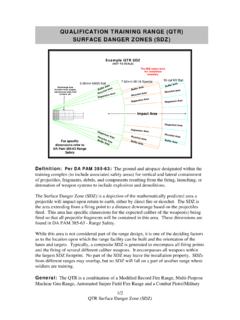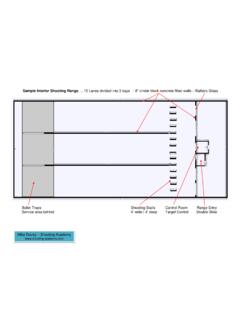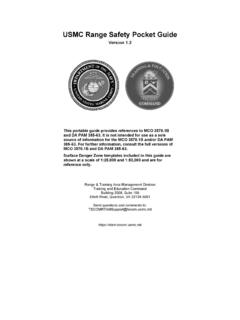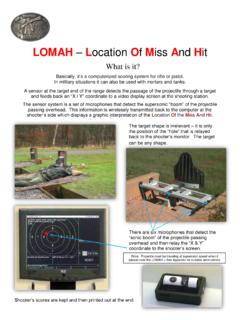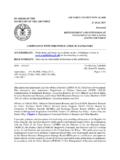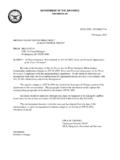Transcription of ETL 08-11 Small Arms Range Design and Construction
1 DEPARTMENT OF THE air force . HEADQUARTERS air force CIVIL ENGINEER SUPPORT AGENCY. 20 OCT 2008. FROM: HQ AFCESA/CEO. 139 Barnes Drive, Suite 1. Tyndall AFB, FL 32403-5319. SUBJECT: Engineering Technical Letter (ETL) 08-11 : Small arms Range Design and Construction 1. Purpose. This ETL provides criteria for the Design and Construction of air force Small arms ranges , and applies to both new Construction and major renovations. Additionally, this document should be used as a guide for any ranges purchased as equipment items. The intent of this ETL is to provide the minimum Design criteria necessary for achieving a safe Range Design . This ETL assumes users have a formal engineering education and background, or access to local engineering expertise. This ETL does not establish the number of firing points, target distance, targetry, or type of Range . A planning team composed of major command (MAJCOM) and installation-level combat arms (CA), civil engineering (CE), bioenvironmental engineer (BE), and safety (SE) personnel will jointly establish the number of firing points, the target distance, and the type of Range based on mission, training requirements, and available real estate.
2 This ETL is directive in accordance with air force instruction (AFI) 32-1023, Design and Construction Standards and Execution of Facility Construction Projects, and AFI 36- 2226, Combat arms Program, and must be used by a Range designer when designing a new Range or renovating an existing Range . The Range designer ultimately has the responsibility to ensure the minimum criteria presented in this ETL are used to provide a safe Range Design . This ETL may not cover all site-specific concerns and it is the designer's responsibility to adapt the intent of the ETL criteria to ensure the Range is operationally safe. This ETL is not a specification or a prescriptive checklist and is not intended to replace professional judgment by a competent licensed professional engineer, after coordination with the end-user or installation CA section. Additionally, nothing in this ETL should preclude consideration and use of emerging technologies and commercially available products if these can be proven to result in a safe and otherwise satisfactory Range Design .
3 This ETL supersedes ETL 06-11, Small arms Range Design and Construction . Note: The use of the name or mark of any specific manufacturer, commercial product, commodity, or service in this ETL does not imply endorsement by the air force . 2. Summary of Revisions. This ETL is substantially revised and must be completely reviewed. It updates requirements and standards consistent with current technology and lessons learned. Editorial updates were performed to improve clarity and organization. This ETL also includes critical improvement to bullet traps that eliminated any blunt surface that would cause ricochet. This ETL incorporates the common general building APPROVED FOR PUBLIC RELEASE: DISTRIBUTION UNLIMITED. requirements in accordance with Unified Facilities Criteria (UFC) 1-200-01, General Building Requirements. Because these salient safety, health, and environmental features of permanent ranges apply to expeditionary or portable ranges , these ETL.
4 Standards should apply toward portable ranges purchased as equipment. 3. Application: All air force installations. The criteria in this ETL shall apply to all Small arms ranges where the Design phase is 35 percent complete or less on the effective date of this ETL. New partially contained ranges will not be designed or constructed. If planned major Range or component repairs of an existing Range will cost more than 50. percent of the estimated Range replacement cost (plant replacement value), the entire facility must be upgraded to comply with this ETL. After MAJCOM approval, HQ AFSFC/SFXW may approve deviations from the criteria in this ETL. MAJCOMs will submit requests for deviation to HQ. AFSFC/SFXW, who will coordinate with HQ AFCESA for review. Authority: air force policy directive (AFPD) 32-10, Installations and Facilities. Effective date: Immediately. Intended Users: MAJCOM functional managers; base civil engineers (BCE).
5 Bioenvironmental engineers; combat arms (CA), and Range designers for the air force . Coordination: MAJCOM functional managers and HQ AFSFC/SFXW. 4. Referenced Publications. In some instances, the references listed in paragraphs through may advocate procedures that seem to contradict those in this ETL. In these cases, the information in this ETL supersedes any other Design and Construction source and policy guidance on Range operation and maintenance contained in AFI 36- 2226 takes precedence over other sources. Public Law: Title 29 Code of Federal Regulations (CFR) , Lead, available at Department of Defense (DOD): DOD Directive , Physical Security of Sensitive Conventional arms , Ammunition, and Explosives, available at Military Handbook (MIL-HDBK) 1027/3B, Range Facilities and Miscellaneous Training Facilities Other Than Buildings, available at MIL-HDBK 1013/1A, Design Guidelines for Physical Security of Facilities, available at 2.
6 UFC 1-200-01, General Building Requirements, available at UFC 3-120-01, air force Sign Standard, available at UFC 4-010-01, DoD Minimum Antiterrorism Standards for Buildings, available at UFC 4-020-01FA, Security Engineering: Project Development (FOUO), available at air force : AFI 31-101, The air force Installation Security Program (FOUO), available at AFPD 32-10, Installations and Facilities, available at AFI 32-1023, Design and Construction Standards and Execution of Facility Construction Projects, available at air force handbook (AFH) 32-1084, Facility Requirements, available at AFI 36-2226, Combat arms Program, available at AFI 90-901, Operational Risk Management, available at air force pamphlet (AFPAM) 90-902, Operational Risk Management (ORM). Guidelines and Tools, available at air force Occupational Safety & Health (AFOSH) Standard 161-2, Industrial Ventilation, available at (hardcopy only). Navy: Navy and Marine Corps Public Health Center Technical Manual (NMCPHC- TM) IH , Indoor Firing ranges Industrial Hygiene Technical Guide, available at Army: Army Pamphlet (PAM) 385-63, Range Safety, available at Training Circular (TC) 25-8, Training ranges NGB-AVS-SG, Policy and Responsibilities for Inspection, Evaluation and Operation of Army National Guard Indoor Firing ranges Environmental Protection Agency (EPA): Best Management Practices for Lead at Outdoor Shooting ranges , available at 3.
7 Industry: American Welding Society (AWS) , Structural Welding Code Steel, ASTM A514/A514M, Standard Specification for High-Yield-Strength, Quenched and Tempered Alloy Steel Plate, Suitable for Welding, ASTM C76, Standard Specification for Reinforced Concrete Culvert, Storm Drain, and Sewer Pipe, ASTM C136, Standard Test Method for Sieve Analysis of Fine and Coarse Aggregates, Illuminating Engineering Society of North America (IESNA) Lighting Handbook, National Rifle Association (NRA) of America, The NRA Range Source Book, latest edition, available at 5. Acronyms and Symbols. AFCESA - air force Civil Engineer Support Agency AFH - air force handbook AFI - air force instruction AFOSH - air force Occupational Safety & Health AFPAM - air force pamphlet AFPD - air force policy directive AR - Abrasion Resistant ( AR500 plate). AR - Army Regulation ASTM - American Society for Testing and Materials AWS - American Welding Society BCE - base civil engineer BHN - Brinnell Hardness Number BMP - Best Management Practices CA - combat arms cal.
8 - caliber CE - civil engineering CFR - Code of Federal Regulations CMU - concrete masonry unit CONUS - continental United States dBA - decibels ( A scale). DOD - Department of Defense DRMO - Defense Reutilization Management Office EOD - explosive ordnance disposal EPA - Environmental Protection Agency ETL - Engineering Technical Letter FOUO - For Official Use Only ft - foot HEPA - high-efficiency particulate air (filter). 4. HMMWV - high-mobility multi-purpose wheeled vehicle HQ AFCESA/CEOA - Headquarters air force Civil Engineer Support Agency, Engineer Support Division HQ AFSFC/SFXW - Headquarters, air force Security Forces Center, Combat arms HVAC - heating, ventilation, and air conditioning IESNA - Illuminating Engineering Society of North America in - inch LAW - light anti-tank weapon LFA - lead-free ammunition LR - long rifle m - meter MAJCOM - major command MIL SPEC - military specification MIL-HDBK - military handbook mm - millimeter mpm - meters per minute NCOIC - noncommissioned officer in charge NMCPHC - Navy and Marine Corps Public Health Center NSN - National Stock Number O&M - operation and maintenance ORM - Operational Risk Management OSHA - Occupational Safety and Health Administration PEL - permissible exposure limit pH - symbol for logarithm of reciprocal of hydrogen ion concentration in gram atoms per liter PPBE - planning, programming, budgeting.
9 And execution psi - pound per square inch RCP - reinforced concrete pipe RH - relative humidity RKT-HEAT - rocket - high-explosive anti-tank SDZ - surface danger zone SE - safety SGPB - bioenvironmental engineer TACOM-ARDEC - Army Tank-Automotive and Armaments Command . Armament Research Development and Engineering Center TBD - to be determined TC - Training Circular UFC - Unified Facilities Criteria VDZ - vertical danger zone 6. Definitions. Small arms Range : A live-fire training facility for training and certifying personnel in the use of handguns, shotguns, rifles up to , rifles or machine guns up to .50 caliber, and the MK-19 40mm machine gun. A Small arms Range may 5. include special ranges for 40mm grenade launchers, light anti-tank weapons (LAW), and 81mm mortars. Equipment items such as fully (self-) contained portable or expeditionary ranges fall into this category. Surface Danger Zone (SDZ): The portions of the Range in the horizontal plane that are endangered by firing a particular weapon.
10 The SDZ includes the area between the firing line and the target line, an impact area, a ricochet trajectory area, and a secondary danger area. The SDZ may also include a weapon back-blast area. The SDZ must be located completely within the boundaries of government- owned or -leased properties. A fully contained Range which is incapable of allowing a fired projectile to escape its limits does not have an exterior SDZ. Vertical Danger Zone (VDZ): For non-contained and partially contained ranges , the VDZ is the volume of airspace above the SDZ between the ground surface and the maximum ordinate of a direct-fired or ricochet round. The height of the VDZ. varies with the weapon and ammunition fired (see Attachment 1). For fully contained ranges , the VDZ is the area between the SDZ and the upper limits of containment. Non-contained Range (Impact Range ): A non-contained Range is an outdoor/open Range . The firing line may be covered or uncovered.

